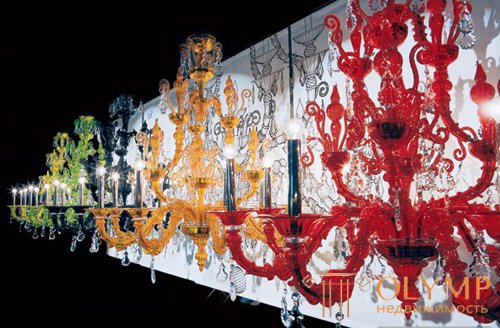
Postmodernism ( fr. Postmodernisme - after modernism ) is a term denoting structurally similar phenomena in the world social life and culture of the second half of the 20th century. Postmodernism refers to the cumulative name of artistic trends that emerged in the 1960s and are characterized by a revision of the position of modernism and the avant-garde.
Postmodernism is a broad social trend that has spread in various areas of culture - philosophy, literature, music, visual arts, architecture. In the style of postmodernism, a fusion of various styles of the past is used, for example, classical and baroque, often applying them with an ironic effect. The specific character of the style is hyperbole as a tool for creating a bright theatrical image of the environment. Departing from Modernism, Postmodernism strives to bring uncertainty and contrast into the order and simplicity of modern styles. The idea often combines color with a historical standard.
On the one hand, Postmodernism is the further development of modernism, and on the other, criticality and even its exclusion in its manifestations. Although at the same time, art is considered fully established. The distinctive features of postmodernism are: the use of ready-made forms, marginality, irony, synthetics and the fusion of the old in a new context.
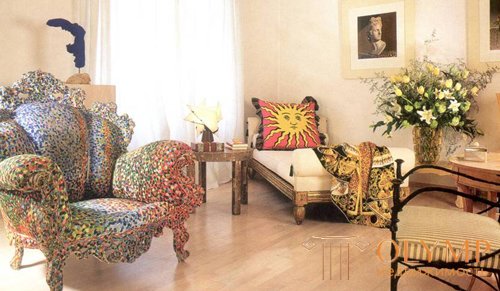
Style Postmodernism in the interior, photo
The main features of Postmodernism are:
The worldview of postmodernism was a deep disappointment in the ideology of historical progress, formulated by the French enlightenment of the XVIII century. and based on the idea of a rational reorganization of society and man. Postmodern philosophers (M. Foucault, J. Derrida) argue that the promised enlighteners of the eighteenth century. the realization of social utopia turned into nightmares of revolution and totalitarianism because it oriented mankind and the individual to an unshakable hierarchy of values, to a certain spiritual center, a moral absolute. The philosophy of postmodernism comes from the attitude that it is the orientation towards the absolute that constantly reproduces totalitarian structures and totalitarian consciousness.
An alternative to it can only be pluralism. In this regard, postmodernism is interpreted in general terms, as pluralism and orientation to a fragment instead of the whole. Naturally, in each of the arts postmodernism focuses on the means of expression inherent in this type of art.
In architecture, postmodernism was formed in the United States theoretically in the second half of the 60s, and in the practice of construction by the end of the 70s, uniting the masters of different creative principles and handwriting. The base that united them was a sharp rejection of the Modern movement as an artistic system, and as a creative ideology claiming the vital socially transformative role of architecture.
Postmodernists have subjected the most severe criticism to such fundamental principles of modernism as functional zoning of cities, asceticism of architectural forms and a serial approach to design, rejection of creative heritage and regionalism.
With all the progressiveness of rational attitudes of functionalism aimed at creating a healthy urban environment and mass hygienic housing, in its ideology for the first time the real customer was replaced by an “average resident”, whose needs the architect had previously researched, evaluated and considered in a typical project. The formation of the external appearance of the building was also rationally determined.
Such an approach did not take into account the objective psychological need of a person for a variety of external impressions and inevitably gave rise to aesthetically and emotionally flawed architecture of mass development, the main characteristic of which was oppressive monotony.
The origin of postmodernism in the architecture of the United States was not accidental. Unlike European architecture, the US architecture did not know the 10–20-year-old “intermission of historicism”. On the contrary, thanks to emigration to the United States during the years of totalism of the founders and leading masters of modernism, its development here was continuous and reached its apogee — the “international style” in the 1950s. Naturally, America has accumulated the greatest “emotional fatigue” from the art of modernism, which led (temporarily) to its “emotional devaluation”. Therefore, the protest became especially sharp here, contributing to the formation of ideology, and then the practice of architectural postmodernism - the only significant area of twentieth-century architecture originated not in Europe.
A radical example in the practical development of the postmodern was one of the largest structures of this style - the ATT office in New York (1978), built according to the design of an ex-modernist, then a neo-classicist (theater in the Lincoln Center in New York, a museum in Nebraska) and now the master of postmodernism - FK Johnson.
Among the town-planning works, the Square of Italy in New Orleans C. Moore and Pennsylvania Avenue in Washington were best known for connecting the buildings of the Capitol and the White House, arch. R. Venturi and D. Rauha.
Beginning in architecture from theoretical premises, postmodernism continued in design as a concept of commercial culture, becoming, as a result, a part of it. Postmodernism has created a new concept of design as a consumer-oriented design. He gave impetus to the search for a bright and meaningful design with a new meaning and ecological morality.
European postmodernism is significantly more rigorous than American. And it is quite natural: new buildings are built in the rich environment of the masterpieces of past centuries, which do not allow gross distortion of historical architectural forms during the "decoration of sheds." At the same time, European postmodernism retains the warmth and humanity of style. The most striking examples of European postmodernism can serve as the expansion of the main art museums in London, carried out in the last decade.
Russian postmodernism, formed under the conditions of “unofficial art”, creates directions parallel to those of the West Sots-art, which became truly massive during the period of perestroika, was its distinctive stylistic branch.
The basic principles of the architecture of postmodernism were formed as the antithesis of modernism. In urban planning, postmodernism professes a rejection of free and gives preference to a regular, predominantly symmetrical development system, as well as a careful one, taking into account the peculiarities of the existing concrete urban environment (“context”).
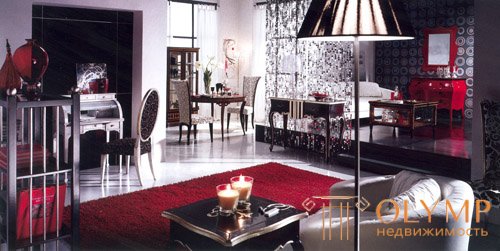
Style Postmodernism in the interior, photo
In the field of architectural forms postmodernism is characterized by the revival (often eclectic) of historical architectural systems and decor of all kinds (decorative masonry, cladding, relief, ornamentation, painting, etc.), appeal to the expressiveness of the wall array with the rejection of the band windows that violate it, the revival of the active silhouette buildings (completion with forceps, gables, attic) with the rejection of flat roofs. Accordingly, the reviving historical forms are restored principles of the historical construction of the composition - symmetry, proportionality, perspective.
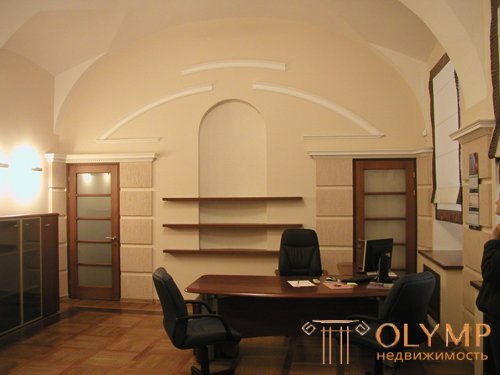
Style Postmodernism in the interior, photo
In the works of theorists and practitioners of postmodernism (R. Venturi, M. Kylo, L. Krie, A. Rossi, A. Gryumbako) formulated his following postulates:
- “imitation” of historical monuments and “samples”;
- “links” to a well-known monument of architecture in the overall composition or its details;
- work in “styles” (historical and architectural);
- “reverse archeology” - bringing the new object in accordance with the old construction equipment;
- “the everyday of realism and antiquity”, carried out by the well-known “belittling” or simplifying the classical forms used.
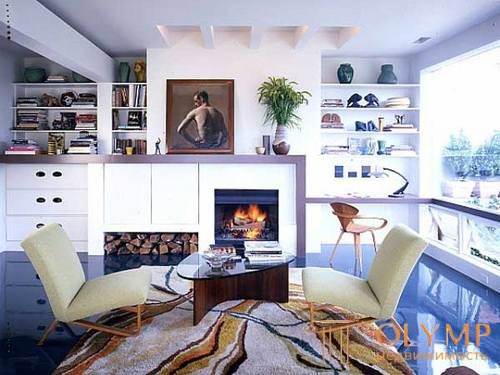
Style Postmodernism in the interior, photo
It is characteristic that tolerance for an eclectic mixture of stylistic forms became typical in the subsequent evolution of postmodernism. This style, while rejecting modern functional analysis, united the various concepts of numerous experimenters who existed at that time. Postmodernism turned to decorativeness and color, kitsch and chic, individuality and figurative semantics of elements, irony and quotation of historical styles. Architects and artists of postmodernism used quotes from not only past styles, but also from surrealism, kitsch, and computer graphics. Postmodernism turned away from monochrome, from rational forms.
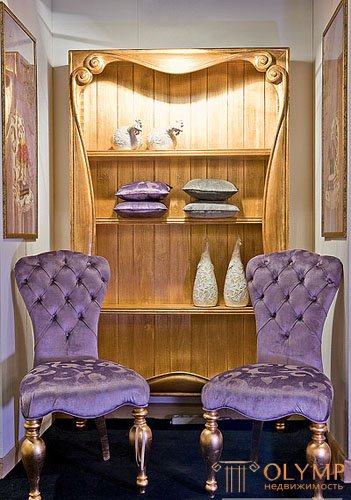
Style Postmodernism in the interior, photo
The postmodern style in the interior is many-sided and is divided into continents, countries, historical epochs, ethnic features, being a game and a cartoon for previous styles. Such diversity is good for the manifestation of your creative imagination and individuality. The style is very energetic and ultramodern. Before choosing this style, you should clearly feel yourself in it.
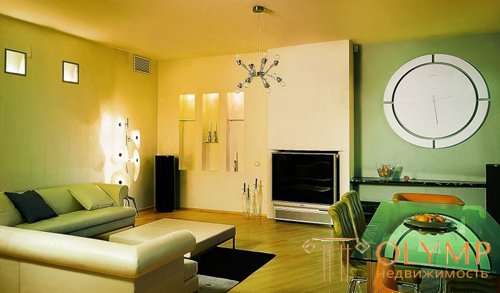
Style Postmodernism in the interior, photo
In the style of postmodernism, there are no preferences regarding the colors, but the priority is bright, energetic colors, also silver, metallic, pearlescent and fluorescent. To make the whole interior bright and caustic is absurd and hard for perception. Therefore, be limited to individual elements, expressed in one bright color or several, chaotically located in the interior, against the background of moderate neutral colors. Such a bright color can stand out as the decoration, and furniture and decor items. Bright colors, as well as, and select the main tone with special attention. The colors of the postmodern style should not bore you and be too “screaming” at the same time. Do not forget about the functional purpose of the room and the appropriate atmosphere.
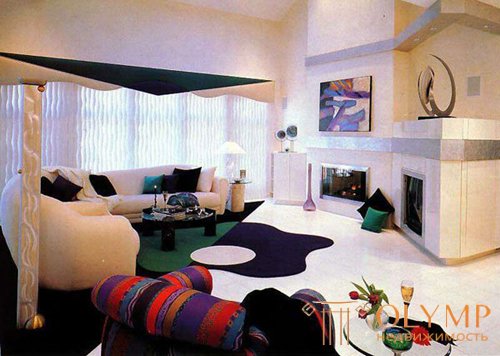
Style Postmodernism in the interior, photo
In the interior of the postmodern, the main thing is fantasy and creative thinking, absolutely any object can be used for a completely new purpose, you can safely break traditional proportions and schemes to achieve the unusualness of postmodernism.
Walls in the postmodern style: The lack of a rigid style that dictates certain finishing materials. More often they are made monochromatic and neutral to accentuate bright decorative objects. On the walls of postmodernism niches, geometric inserts made of metal, glass and even plastic using lighting are appropriate. One of the walls can be decorated with airbrushing.
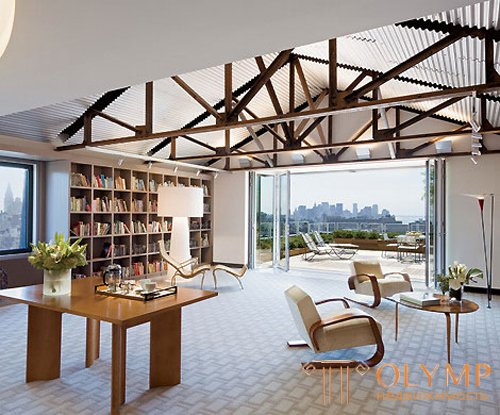
Style Postmodernism in the interior, photo
Postmodern style ceiling: Monotonous, more often multi-level and asymmetrical. Multicolor and the use of bright colors depends on the desired desired effect, the main thing here is not to overplay.
The floor in the postmodern style: Depends only on the required quality of the floor covering and the functional purpose of the room (bathroom, living room, kitchen, etc.), otherwise it is not limited. The ornament or texture (for example, parquet) is strict and clear. If you choose a carpet, it is bright, solid with a geometric shape or asymmetrical. Also for carpet, but more often it is chosen monochromatic neutral color.
Furniture in the postmodern style: In furniture design, postmodernism was expressed primarily in the new stage of the development of the classics, which eclectically reworked the legacy of the “big” styles.
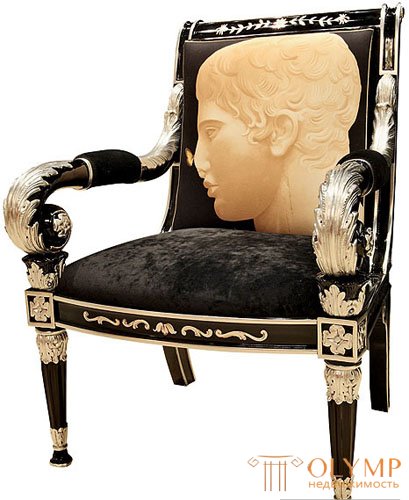
Style Postmodernism in the interior, photo
In the postmodern, free, dynamic lines, symmetrical and asymmetrical forms, and also transforms prevail. The style of postmodernism is inherent heterogeneity, in one interior can be furniture of a strict form together with a smooth and streamlined. Synthetic leather, nickel-plated and chrome-plated materials have found wide application in postmodern. Appropriate futuristic furniture. There should be no overload try to minimize the amount of furniture.
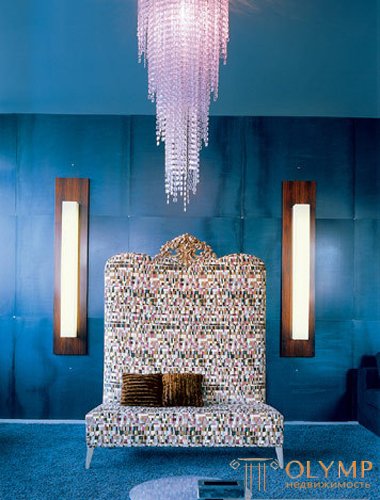
Style Postmodernism in the interior, photo
Decor in the style of postmodern: In the spirit of modern art objects. Fancy figurines of various materials (metal, plastic, ceramics). Plants in geometric pots with a bright ornament, branchy dried flowers. Colored glass (vases, dishes, glass beads in a vessel). On the couch and chairs multi-colored pillows. Items should not be much, they are all relevant and holistically arranged.
Art objects in the interior of postmodernism must also be very bold and even fanciful. If the pictures are bright and saturated in the spirit of abstractionism, cubism, post-impressionism, or even dadaism. Prints fit perfectly (posters or posters).

Style Postmodernism in the interior, photo
In the style of postmodernism is important lighting. It is as rich and diverse as the entire interior. At the same time, a large chandelier of an unusual shape (for example, in the form of a chrome-plated branch ball) is combined with numerous halogen lamps. To add bright colors to the lighting using neon lamps.
Postmodernism in the interior is a rejection of stereotypes and routine, a harmonious combination of all elements of the interior. In the absence of any visible logic, the postmodern style is quite realistic. In the interior of postmodernism there are clear patterns, the use of bright colors, the introduction of the symbolism of forms, a contrasting combination of textures and textures. The style is characterized by spacious rooms with light and original designs.
Postmodern style interior is more common in restaurants, clubs, beauty salons, as well as bohemian apartments, featuring an asymmetrical and free layout, as well as an unconventional approach to design.
Что бы оставить комментарий войдите
Комментарии (0)